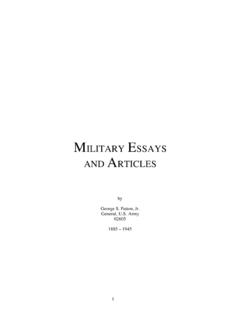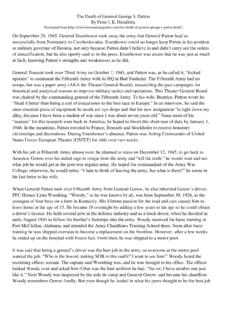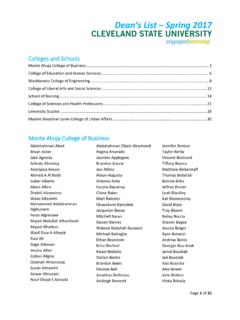Transcription of George S. Patton, Jr. U.S. Army, 02605 1885 — 1945 Charles ...
1 George S. patton , Jr. army , 02605 1885 1945byCharles M. ProvinceHe s been called a number of things, including military genius, a legend, and a son-of-a-bitch. But, almost 50 years after his death,he s still considered to be the one army General epitomizing the fighting soldier of World War was a man of contradictory characteristics. He was a noted horseman and polo player, a well-known champion swordsman,and a competent sailor and sportsman. He was an amateur poet. Sixteen of his analytical papers were published in military magazines, thetrade journals of the military profession. While he was a rough and tough soldier, he was also a thoughtful and sentimental in his actions, he was always dependable. He was outgoing, yet introverted. History proves him to be a complex andparadoxical s mostly remembered for his unique brand of leadership. It was a role he cultivated and fully exercised. He managed to obtain asupreme effort from his men. His charisma, symbolized by a flamboyant and well-publicized image, stimulated his troops to an incrediblelevel.
2 His unflagging efforts generated desire from his soldiers to fight and destroy the personified the offensive spirit, a ruthless drive, and an imperative Will To Conquer. Being the prominent champion of combateffectiveness, particularly with respect to the employment of armored forces, patton elevated the blitzkrieg (lightning war) concept to astate of scientific occasionally brutal methods were, for the most part, approved by his men. patton s battle hardened soldiers understood andshrewdly sanctioned his actions. They were fully cognizant of war s demands. They also knew that if anyone could help them to gethome alive, patton was the understood that war means fighting and fighting means killing. He s the one soldier from the Second World War who standsapart from the rest, who best personifies that murderous concept, who embodies indispensable warlike virtues, and the Will To , without deviation, exerted his full energies toward the pursuit of excellence.
3 He fought the temptations to relax, to be lazy. Hewas harder on himself and more demanding of himself than he was of any Davis Wilson was a remarkable man a pioneer, trapper, adventurer, Indian trader and Indian fighter, and finally, arespectable man of means. Born in Tennessee, he worked his way across the American continent to southern California long before it wasCalifornia. By marrying a daughter of a wealthy Mexican he gained vast landholdings. After the death of the first Mrs. Wilson, Benjaminmarried an American citizen. The second Mrs. Wilson gave birth to a daughter who would eventually meet and marry George S. Patton, Sr. Their union would produce the future general and World War II commander of the famous United States Third Benito Wilson, as he was called by the Mexicans and Indians of Old California, established orange industry in California,planted the first vineyards, and furnished the name for Mount Wilson. Twice elected to the state legislature, he was highly and widelyrespected.
4 Don Benito was the future general s patton side of patton s family regarded themselves as genteel Virginians. Their lineage was traced to George Washington andbeyond that to a king of England and a King of France. The Pattons were reportedly related to at least 16 signers of England s MagnaCharta. This is the heritage of General PattonAt age 11, patton entered a private school in Pasadena, California. At 18 he entered the Virginia Military Institute, following in thetradition of his father and grandfather. Compiling a splendid record, he received no demerits in a full year s accepted an appointment to the United States Military Academy at West Point after a year at Virginia Military Institute. Theprincipal reason for entrance to the Academy was because upon graduation he would automatically receive a commission in the UnitedStates 1909, he graduated 46th in a class of 103. He had held the rank of Cadet Corporal, Sergeant Major, and Adjutant. He won hisschool letter by breaking a school record in the hurdles event.
5 Upon graduation, he became a Cavalry officer and soon afterward, marrieda charming young lady from Massachusetts. Her family was immensely wealthy, her father owning the American Woolen 1912, patton attended the Olympics held at Stockholm, Sweden. That same year, a young Indian named Jim Thorpe made historyby winning and dominating the competed in the modern military pentathlon. The events included pistol shooting, a 300 meter swim, fencing, a steeplechase,and a cross-country foot race. He finished a very respectable fifth the games, and at his own expense, patton traveled to the French Cavalry School located at Saumer, France to take lessonsfrom the fencing instructor there. He purposely cultivated his own reputation as a swordsman, and he later designed a saber that theUnited States Cavalry adopted; the M-1913 Saber. Long before he became known as Old Blood and Guts (a name he hated), he wasknown as Saber George . For a very young second lieutenant, it was a great assignment to the Cavalry School at Fort Riley, Kansas, he took over the instruction of the Cavalry Course where he instructedthe men in the use of the new saber he had designed.
6 His impressive title was Master of the Sword. He was the first to hold the newlycreate title and he was only a second March of 1916, Pancho Villa and several hundred of his bandits raided the town of Columbus, New Mexico, killing a total of 17 American citizens. Villa s reasoning for this barbaric butchery was that he was angry at the American government because it refused toassist him in his revolution and his attempted takeover of the Mexican response to the raid, General John J. Pershing organized a Punitive Expedition to pursue Villa into Mexico. Pershing s action wasprompted by the Mexican government s inaction. They refused to do respond to Villa s criminal took patton along as an unofficial aide, giving him a variety of duties, most of which patton considered dull anduninspiring. He longed for some action, some contact with the enemy. He finally got his chance in May of the month of May, patton was in charge of a 15 man contingent traveling in three Dodge Touring Cars, for the purpose ofbuying corn from Mexican farmers.
7 Relying purely on a hunch, patton led a raid at a place called the Rubio Ranch, believing that one ofVilla s men might be there. As it turned out, not one, but three of the enemy were there and during their attempted escape, patton and hismen engaged them in a lively skirmish resembling an old western movie gun fight. All three of the banditos were triumphantly strapped the bodies to the cars, one on each hood. He took them directly to Pershing s headquarters foridentification where he created quite a commotion. Later, he carved two notches in his Ivory-Handled Colt .45 to commemorate hisgood fortune. After that, Pershing always referred to patton as his it was the only real action to come out of the entire expedition, young Lieutenant patton immediately became a nationalhero. Newspapers in the United States carried stories about his exploits for a full week before the furor died importantly, patton s actions signaled the inauguration of motorized warfare.
8 It was the first time a United States Armycontingent engaged an enemy using motor service in Mexico was monotonous, patton took the opportunity to observe General Pershing closely, studying himassiduously. patton learned how Pershing operated, how Pershing gave orders, trained his men, judged his subordinates, maintained troopmorale, and carried out his command duties. patton began to model himself after the General Pershing assumed command of the American Expeditionary Force (AEF), heading for France in World War I, he decided totake patton with performing boring, tiresome office jobs the AEF headquarters, patton became interested in a new contraption called a were not only new, they were also unreliable, unwieldy, and unproven instruments of warfare. There was a great deal of doubt as towhether or not tanks even had any function or value on the was the first officer assigned to the United States Tank Corps. Throwing himself into his job with his usual enthusiasm, hequickly became the AEF s leading tank almost single-handedly formed the American Tank School.
9 He wrote the training manuals, devised the training doctrine andmethodologies, wrote a seminal paper which became the basis for the United States Tank Corps. He taught and trained his tankers, andeventually led them into the first day of the Meuse-Argonne Offensive, patton was very nearly killed. A bullet striking him in the upper leg, passedcompletely through him, finally ripping out a large piece of flesh. It tore a large hole in the rear of his lower cheek. In spite of his profusebleeding, he kept advancing, until the loss of blood forced him to stop. He was luckily evacuated to a rear echelon hospital before he bledto death on the battlefield. It was the final combat that he would see in WWI. The armistice was signed on the day that he sneaked out ofthe hospital to return to his was this wound that occasionally prompted patton to refer to himself as a half-assed the armistice was signed, patton returned to the United States as an officer of the Tank Corps, but shortly afterward, hereturned to his first love; the major reason for his departure from the Tank Corps was the stinginess of the Congress.
10 After Congress allotted a total of$500 for a full year s worth research and development for the Tank Corps, patton realized that during the years of peace there would beno American development of the tank because of the miserly Congress. He was development of the tank and armored doctrine was stagnated in the United States. It took the events of the Second World Warand the German blitzkrieg to open the eyes of the pacifistic the 1920 s and 1930 s, patton served in a variety of assignments where he completed his military education. He was an honorgraduate of the Command and General Staff College at Fort Leavenworth, and a distinguished graduate of the army War the early 1930 s, while stationed at Pearl Harbor, patton wrote a highly prophetic discussion paper. Its subject matter dealt withthe possibility of an air attack by the Japanese against the Hawaiian Islands. patton held the firm opinion that Japan had explicit anddefinite ideas about domination of the Pacific Basin.








